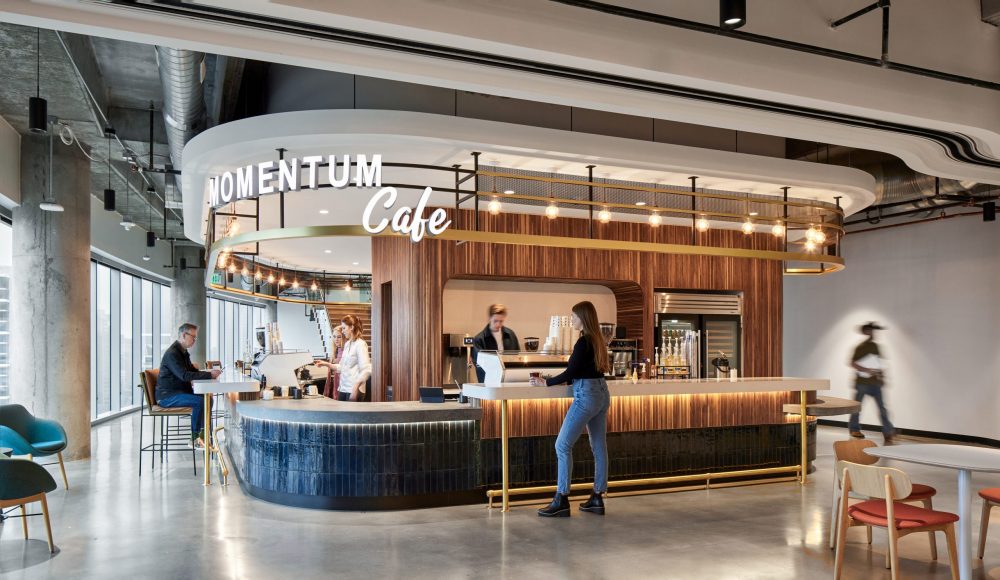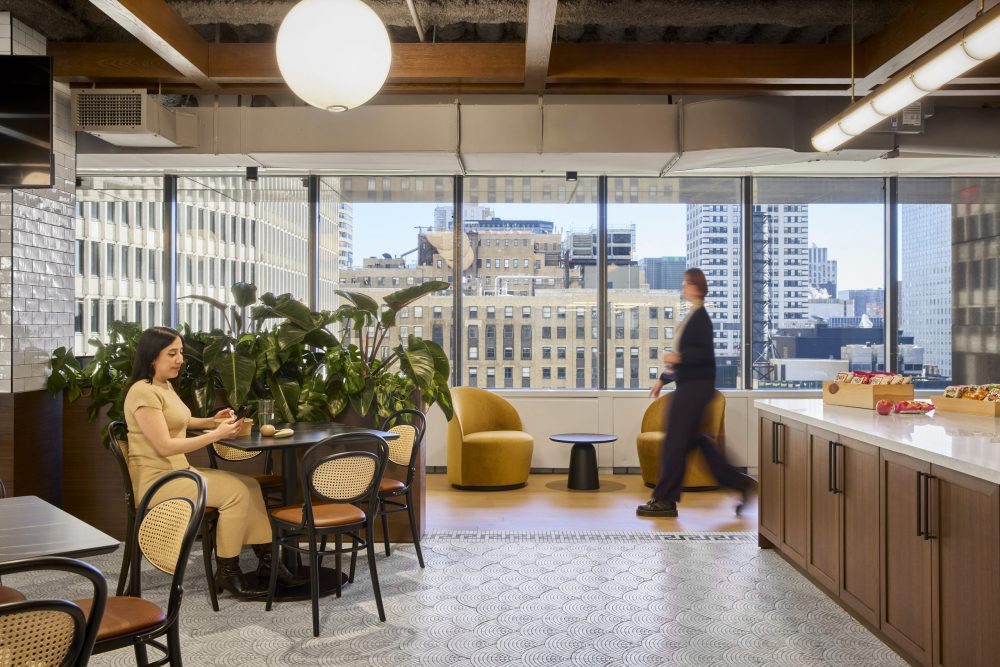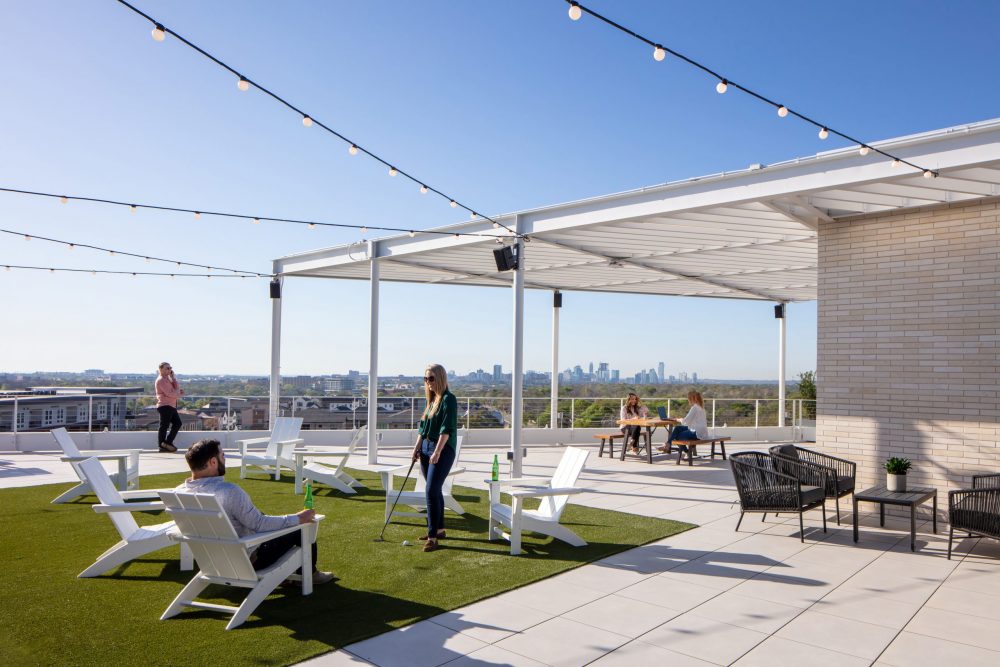Seventy-four percent of companies now operate in a hybrid model, but the real challenge lies ahead: reimagining the office as a destination that draws people in.
Employers are seeking fresh, inspiring ways to make in-person work irresistible — boosting day-to-day satisfaction, productivity and retention. A decade ago, that innovation looked like enhanced amenities: standing desks, grab-and-go snacks and on-site fitness centers to cater to employees spending long hours in the office Monday through Friday. Now, the flexibility of hybrid work has redefined work-life balance and with it, the definition of the workplace…and what it takes to earn the commute.
Today’s workers want more out of their commute than a pingpong table or espresso machine. Beyond autonomy in choosing spaces that support both connection and focus inside the office, they want access to “amenities” outside the office. To meet these expectations, organizations need to think beyond their physical office space to the surrounding neighborhood. Vibrant, walkable, engaging districts give employees an array of places to connect and recharge — and a more compelling reason to come into the office.

An Emerging Workplace Differentiator
According to a recent Corgan survey identified restaurants, cafes, shops, and green space as the top neighborhood amenities (besides parking) that influence employees’ desire to return to the office. These “third places” are anchors that enhance convenience, social connection and moments of focus and well-being throughout the day. While office design and thoughtful amenities are still important to employees, what makes a workplace truly compelling is how it enhances their day. Employees want the convenience of the office and the option to take advantage of neighborhood amenities. For example, an in-office coffee station doesn’t replace the desire for a nearby coffee shop — employees want both options. Returning to the office becomes much more attractive when the office itself is surrounded by neighborhood amenities that rival or even improve upon those around employees’ homes.
For companies seeking to differentiate the in-person experience, the urban vibrancy of the surrounding neighborhood is a new frontier to pursue. The density and diversity of amenities, walkability, and proximity to the city center or major business districts are consistently linked to greater urban vitality. Employers and landlords have a win-win opportunity: partner with local businesses and city planners to co-create ecosystems that support the rhythm of the workday. This includes integrating parks, fitness studios, childcare services, wellness vendors, and cultural institutions that serve employees and residents alike.

Vibrant Neighborhoods Fuel Satisfaction and Retention
As employees seek greater autonomy and work-life balance, neighborhoods have taken on a new role in the workplace ecosystem. This means evaluating not only office interiors, but also the sidewalk experience, street-level retail and public space activation.
More than an amenity, neighborhoods can be drivers for how people feel, perform and connect — and social connection is one of the strongest predictors of employee well-being and performance. According to research published in the Harvard Business Review, employees with strong social ties at work report higher engagement and resilience, while loneliness correlates with lower productivity and higher burnout. Likewise, Gallup data shows employees who have a best friend at work are more than twice as likely to report being extremely satisfied with their workplace — and are 25% less likely to be actively searching for a new job — than their friendless counterparts.
When People Linger, Connection Follows
Emerging neighborhood models point toward a future where everything employees need is just a short walk or bike ride away. In these areas, workers don’t just clock in and out, but meet for a mid-day coffee, linger for a happy hour, or a walk in the park — all activities that facilitate connection between coworkers. According to a Glassdoor survey, nearly half of employees struggle to connect with coworkers in a hybrid environment. Companies are looking for opportunities to enhance the spaces between meetings: welcoming sidewalks, local cafés, green spaces that make connections stick and counteract this struggle.
Social connection isn’t just good for workplace morale — it is part of the bottom line for local businesses, too. On average, employees spend approximately $3,000 annually on after-work hangouts like happy hours, dinners, and casual meetups. These moments build trust, team culture and a sense of belonging: a 2022 EY survey reported that 80% of employees with close work friends feel more connected to their organizations and 86% report higher satisfaction with their work compared to employees without close work friends. The link between social spending and job satisfaction illustrates a mutually beneficial dynamic for developers and companies — a well-developed neighborhood encourages more spending, which in turn helps boost employees’ satisfaction.

No Office is an Island
Great offices don’t exist in isolation. For many workers, the neighborhood that surrounds the workplace is taking on new significance. Employees increasingly evaluate the entire experience of going to work, factoring in local amenities, walkability, and opportunities for connection.
As companies size up their strategies and seek to re-energize the workplace, the focus must expand from square footage to city blocks. The most competitive workplaces will be those that balance in-office assets with neighborhood experiences, creating a well-rounded environment that supports not only productivity, but also connection, well-being, and belonging.


